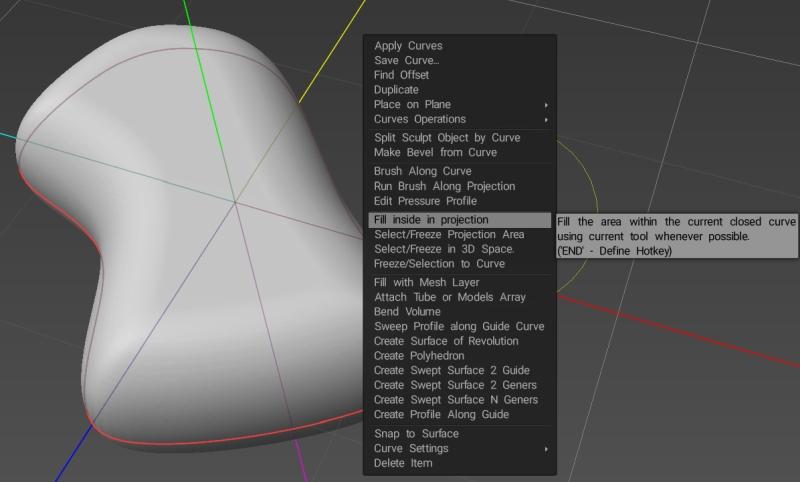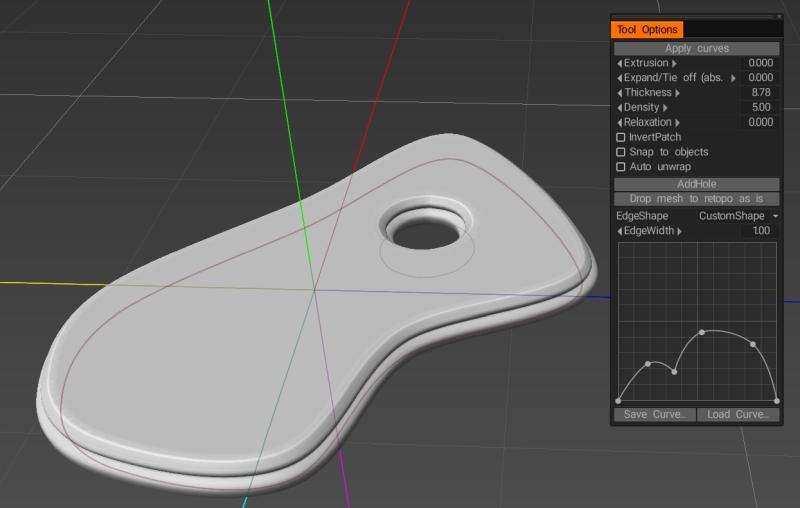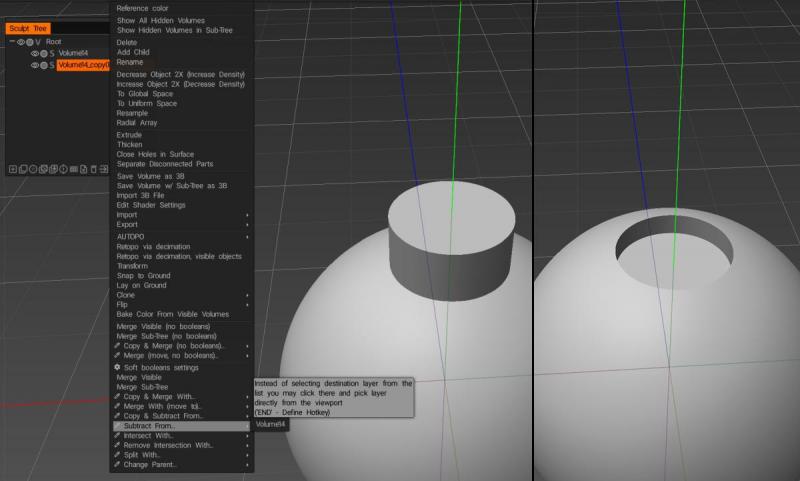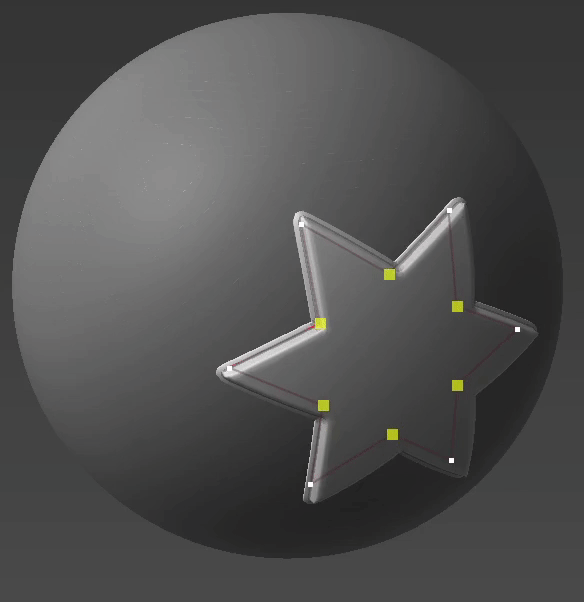Δημιουργήστε πλέγματα χρησιμοποιώντας καμπύλες 2D: πώς γίνεται όλο αυτό.
Αφράτο:
Φαίνεται ότι η μέθοδος που χρησιμοποιούν σε αυτό το βίντεο χρησιμοποιώντας το εργαλείο Sphere είναι η χρήση του σε συνδυασμό με την επιλογή Fill inside projection την οποία μπορείτε να βρείτε κάνοντας δεξί κλικ στην καμπύλη στο κύριο παράθυρο ή στον πίνακα Curves Tree.
Ωστόσο, φαίνεται ότι μπορεί να χρησιμοποιούν μια παλαιότερη έκδοση του 3D Coat , καθώς οι επιλογές εργαλείου για το εργαλείο Sphere είναι διαφορετικές από αυτές της έκδοσης 2022.55. Το παραπάνω αντικείμενο δημιουργήθηκε χρησιμοποιώντας το εργαλείο Blob (βρίσκεται ακριβώς πάνω από το εργαλείο Sphere) το οποίο εξακολουθεί να έχει την επιλογή Round Border που φαίνεται στο βίντεο.
Εκτός από τη χρήση του εργαλείου Blob αντί του εργαλείου Sphere, η διαδικασία που χρησιμοποιήθηκε για τη δημιουργία του αντικειμένου στην παραπάνω εικόνα είναι η ίδια. Με τις καμπύλες φορτωμένες, μεταβείτε στην Κάτοψη και βεβαιωθείτε ότι χρησιμοποιείτε ορθογραφική προβολή αντί για προοπτική και, στη συνέχεια, με επιλεγμένο το εργαλείο Blob κάντε δεξί κλικ στην απαιτούμενη καμπύλη και επιλέξτε Συμπλήρωση εντός προβολής (η ακτίνα του πινέλου υπαγορεύει πόσο πάχος θα είναι το αντικείμενο που προκύπτει ).
Προσωπικά θα συνιστούσα να δοκιμάσετε μια εναλλακτική μέθοδο χρήσης Curves. Αντί να επιλέξετε Πλήρωση μέσα προβολής από το μενού, δοκιμάστε να χρησιμοποιήσετε το Fill with Mesh Layer (βρίσκεται πιο κάτω στο ίδιο μενού). Δημιουργεί ένα νέο στρώμα σε λειτουργία επιφάνειας και δημιουργεί ένα αντικείμενο πλέγματος με βάση την επιλεγμένη καμπύλη και παρέχει ένα σύνολο επιλογών που σας επιτρέπουν να ορίσετε πάχος, πυκνότητα πλέγματος, χαλάρωση κ.λπ. ή ορίζοντας το δικό σας προσαρμοσμένο σχήμα άκρων και επιτρέποντάς σας να προσθέσετε τρύπες δημιουργώντας περισσότερες καμπύλες σε ένα υπο-στρώμα της τρέχουσας καμπύλης.
Ακόμα καλύτερα όταν χρησιμοποιείτε το Fill with Mesh Layer, το αντικείμενο πλέγματος και η καμπύλη παραμένουν συνδεδεμένα, οπότε όταν προσαρμόζετε το σχήμα της καμπύλης, το προσαρμοσμένο σχήμα άκρων ή διάφορες άλλες ρυθμίσεις που χρησιμοποιούνται για τη δημιουργία του αντικειμένου, αυτές οι αλλαγές εφαρμόζονται αυτόματα στο αντικείμενο μέχρι ώρα που επιλέγετε να τα αποσυνδέσετε.
AbnRanger:
Επιτρέψτε μου να προσπαθήσω να βοηθήσω λίγο. Νομίζω ότι ξέρω τι εννοείς, αλλά μπορεί να είμαι εκτός στόχου.
1) Εάν θέλετε να import ένα σχήμα Vector από κάτι σαν αρχείο Illustrator, φροντίστε να αποθηκεύσετε το αρχείο Illustrator ως αρχείο EPS.
2) Στο Sculpt Workspace, μεταβείτε στο μενού CURVES και επιλέξτε LOAD CURVE ή LOAD CURVE FROM IMAGE
Με το Curves τώρα σε 3DCoat, μπορείτε να χρησιμοποιήσετε διάφορα εργαλεία για να προσθέσετε όγκο, αλλά κάτι σαν το εργαλείο Sphere θα λειτουργήσει…
3) Επιλέξτε τη λειτουργία σχεδίασης CLOSED SPLINE, στη δεξιά πλευρά του E-Panel (πατήστε το πλήκτρο E για να φέρετε τον πίνακα στον δρομέα σας)
4) Επιλέξτε το πρώτο εικονίδιο…το εργαλείο επιλογής SEGMENT > επιλέξτε το σχήμα/καμπύλη που θέλετε να συμπληρώσετε
5) RMB κάντε κλικ στην καμπύλη και επιλέξτε FILL INSIDE PROJECTION….αλλά μπορείτε επίσης να επιλέξετε BRUSH ALONG CURVE για να γεμίσει ακριβώς κατά μήκος της καμπύλης.
6) Υπάρχουν λειτουργίες boolean που μπορείτε να χρησιμοποιήσετε από το Μενού ΚΑΜΠΥΛΕΣ > ΛΕΙΤΟΥΡΓΙΕΣ ΚΑΜΠΥΛΩΝ… αλλά θα μπορούσατε επίσης απλώς να επιλέξετε την καμπύλη που θα κόβει/αφαιρείται όταν επαναλαμβάνετε το βήμα 5, εκτός από αυτή τη φορά που κρατάτε πατημένο το CTRL ενώ το κάνετε.
Όταν χρησιμοποιώ το γέμισμα με Mesh Layer, αν μετατρέψω σε Voxels (ή Multires σε λειτουργία επιφάνειας) χάνω τις αιχμηρές άκρες μου. Υπάρχει τρόπος να διατηρηθούν οι αιχμηρές άκρες κατά τη χρήση αυτής της μεθόδου;
Αφράτο:
Εάν θέλετε να αλλάξετε σε Voxel, ίσως χρειαστεί να αυξήσετε την ανάλυση του επιπέδου voxel για να διατηρήσετε αιχμηρές άκρες ή λεπτές λεπτομέρειες. Λάβετε υπόψη ότι η αύξηση της ανάλυσης ενός επιπέδου voxel αυξάνει την ανάλυση ολόκληρου του αντικειμένου, ώστε να μπορείτε να καταλήξετε με πολλά πολύγωνα στην οθόνη όταν εργάζεστε με μεγάλα αντικείμενα.
Συνήθως προσπαθώ να εκτελώ λειτουργίες boolean σε λειτουργία Voxel , καθώς είναι συνήθως πιο αξιόπιστες, αλλά αν θέλετε να διατηρήσετε αιχμηρές άκρες χωρίς να χρησιμοποιείτε αντικείμενα voxel πολύ υψηλής ανάλυσης, μπορείτε να δοκιμάσετε να παραμείνετε σε λειτουργία Surface. Είτε έτσι είτε αλλιώς, μπορείτε να κάνετε boolean δύο επίπεδα μαζί κάνοντας δεξί κλικ σε ένα από τα επίπεδα και επιλέγοντας μία από τις επιλογές boolean (Συγχώνευση με, Αφαίρεση από, Τέμνηση Με, κ.λπ.) και στη συνέχεια επιλέγοντας το άλλο επίπεδο.
Η χρήση Curves θα ήταν μια πολύ καλύτερη λύση για την εξώθηση της μετατόπισης, ειδικά σε συνδυασμό με το εργαλείο Coat (το οποίο μπορεί να προσπελαστεί κάνοντας δεξί κλικ σε μια καμπύλη και επιλέγοντας Fill with Mesh Layer ), το οποίο όχι μόνο σας επιτρέπει να ορίσετε προσαρμοσμένα περιγράμματα για την εξωθημένη άκρη σας.
… μπορείτε να τροποποιήσετε το σχήμα ανά πάσα στιγμή μετά τη δημιουργία του (μέχρι να αποσυνδέσετε σκόπιμα την καμπύλη από το αντικείμενο)…
 Ελληνικά
Ελληνικά  English
English Українська
Українська Español
Español Deutsch
Deutsch Français
Français 日本語
日本語 Русский
Русский 한국어
한국어 Polski
Polski 中文 (中国)
中文 (中国) Português
Português Italiano
Italiano Suomi
Suomi Svenska
Svenska 中文 (台灣)
中文 (台灣) Dansk
Dansk Slovenčina
Slovenčina Türkçe
Türkçe Nederlands
Nederlands Magyar
Magyar ไทย
ไทย हिन्दी
हिन्दी Tiếng Việt
Tiếng Việt Lietuviškai
Lietuviškai Latviešu valoda
Latviešu valoda Eesti
Eesti Čeština
Čeština Română
Română Norsk Bokmål
Norsk Bokmål



